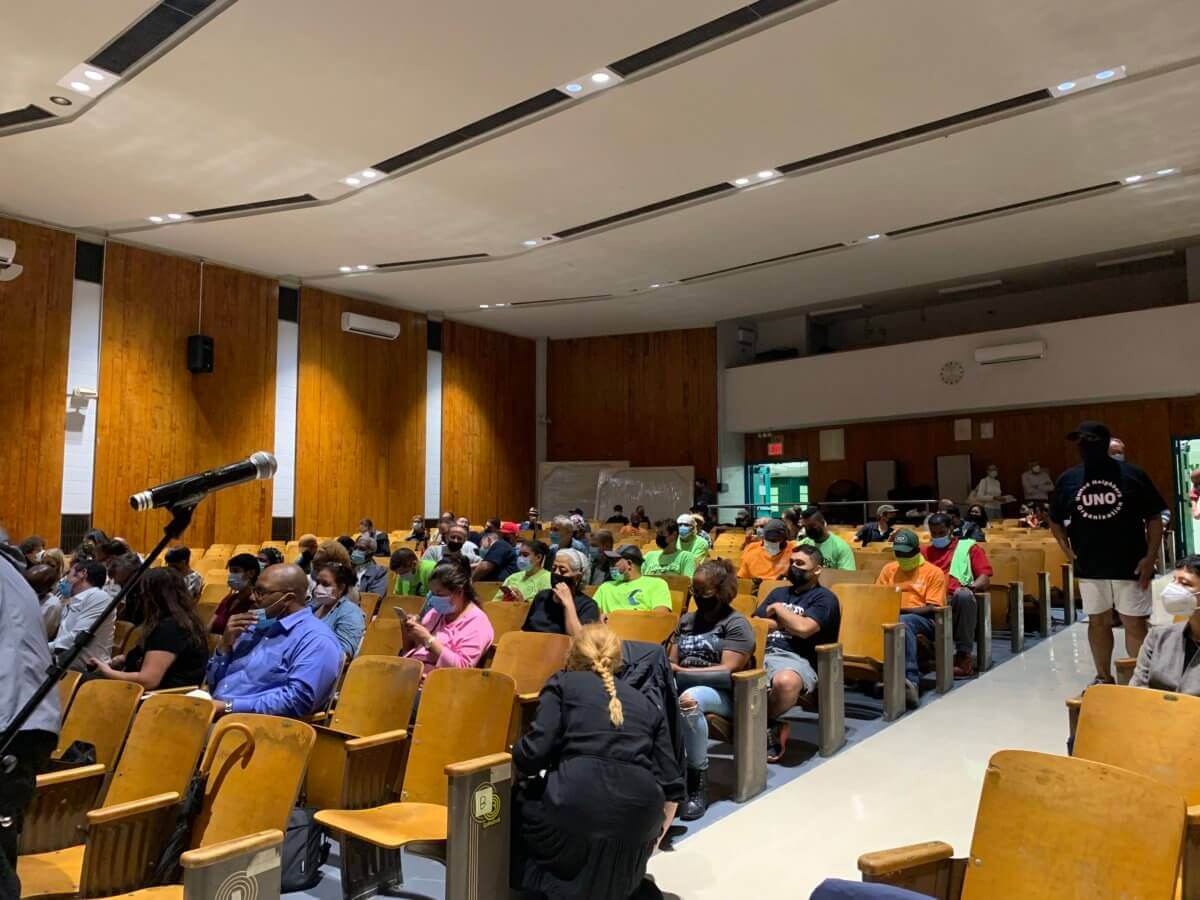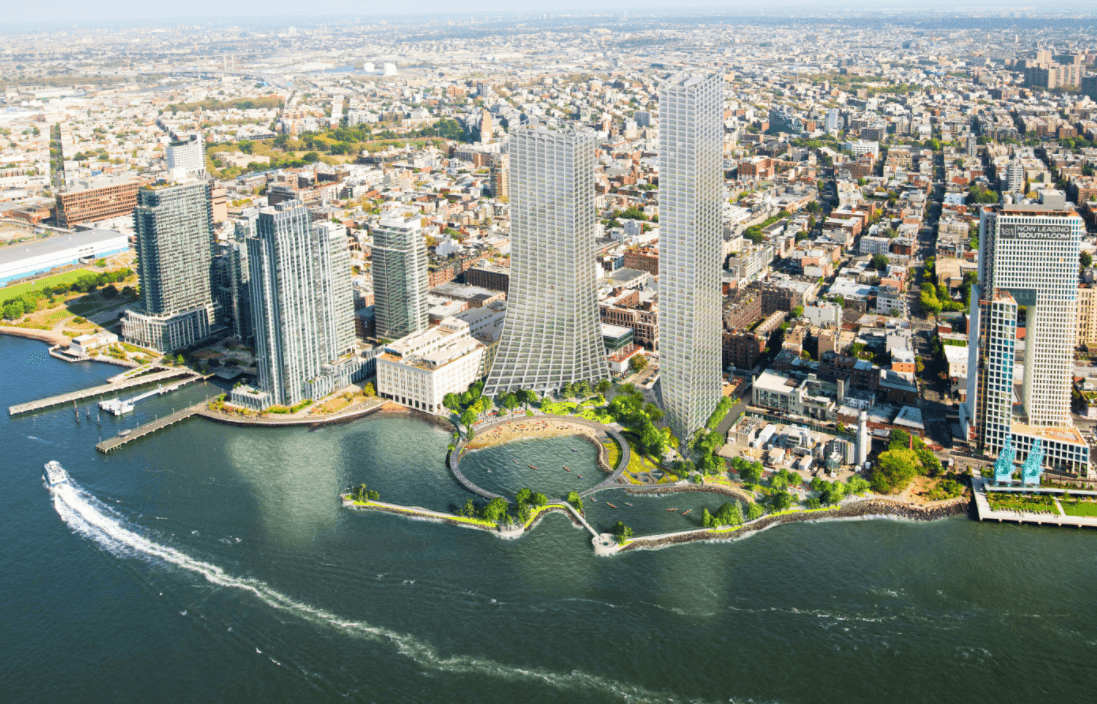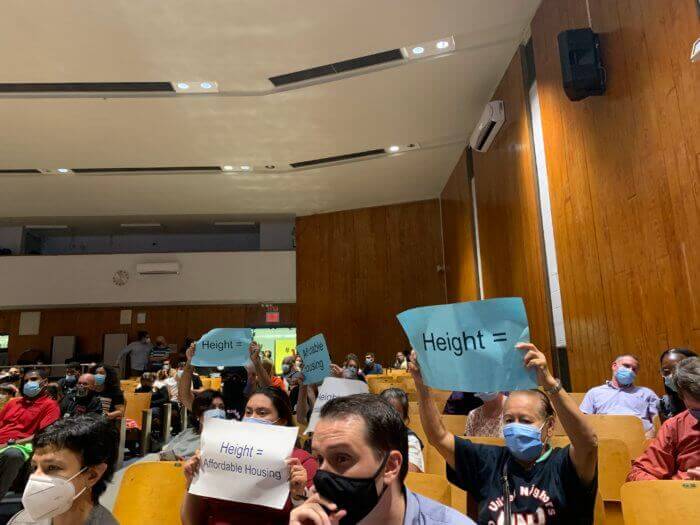Locals Ask About Affordable Housing at Packed Hearing on Two Trees' Latest Williamsburg Towers
Other concerns included jobs and climate resiliency for the waterfront development, which would include a park and pool, by Two Trees and Bjarke Ingels Group.

Union workers and neighbors gathered to look at a model of the proposed River Ring development in Williamsburg. Photo by Kirstyn Brendlen
Developer Two Trees was back before Community Board 1 on September 1 to present their proposed pair of massive waterfront towers, which kicked off the city’s lengthy rezoning process last month.
The building company is hoping to bring two mixed-use high rises, along with a large public park, to the Williamsburg waterfront, and have tapped renowned architects at Bjarke Ingels Group to design the project.
The developer has been meeting with neighbors since summer 2019, including bringing the proposal to CB1 twice in early 2020 — but now the real effort begins, as they’ve had their rezoning application certified by the City Planning Commission last month.
Hundreds of people — including the Democratic nominee for borough president, Antonio Reynoso, and the area’s likely next council member, Lincoln Restler — gathered in an auditorium at MS 126 for the board’s first in-person meeting in over a year.

Outside the school, as the remnants of Hurricane Ida started to pour rain onto the borough, more than 50 members of the New York City & Vicinity Council of Carpenters waited to head inside, wearing brightly colored union T-shirts and holding signs reading “JOBS JOBS JOBS,” and “Stop the cycle of poverty!”
The group hopes Community Board 1 will tack on some conditions to the project that would foster career development for locals, if the board approves the proposal.
“We’d be hypocritical to say we’re against development,” union representative Rubén Cólon told Brooklyn Paper. “But what we are for is responsible development, so we’re hoping the community board will attach some conditions so that the developer provides careers versus jobs.”
The pandemic left many unrepresented construction workers without work, benefits and pay, Cólon said.
“We’re actually in discussions with the developer in the hopes that he will sign, at the very least, some kind of MOU, or memorandum of understanding, that includes some kind of benefits and wages for the workers,” Cólon said. “If not full union work across the board. That’s the ideal situation.”
While construction jobs are temporary, Cólon said, in the modern “gig economy,” eight three-year contracts can constitute a career. More than 20,000 members of the union live in New York City, many in Brooklyn, and they need work, added representative Sinade Wadsworth.
Most of the union members filed out of the meeting before they could testify, though it wasn’t in opposition to the project, Wadsworth said, just a matter of getting home to bed before an early morning alarm.
The St. Nicks Alliance, a Williamsburg-based nonprofit, is also hoping to place job seekers from its Workforce Development Center at the site, both in temporary construction jobs and in temporary maintenance and retail positions when construction has finished.
Inside the school, more than 100 people had signed up to testify during the meeting, said Del Teague, chair of the land use committee. Teague asked that whether they were for or against the project, speakers keep their testimony to under a minute.
“We know that right now there is a gap in the continuity in the waterfront between Williamsburg and Greenpoint,” said Two Trees architect Laura Cheng, as she presented the project. “This project seeks to fill that gap, not just physically, but also understanding that this part of River Ring is going to function as part of a broader network.
“And to think about what are the types of programming, the types of experiences, the quality of spaces that maybe don’t currently exist, and filling those gaps as well.”
The public park Two Trees is planning for the waterfront would feature new nature paths built out into the water, including an outdoor classroom, a bird hide, and a play area. The developer has emphasized the importance of climate resiliency in the design, planning to include a salt marsh and tidal pools to create calm habitats for native wildlife, and oyster cages.

Karen Imas, vice president of programs for the Waterfront Alliance, said the organization supports the project and its focus on climate, and said the project is currently in the process of obtaining “Waterfront Edge Design Guidelines” certification provided by the alliance.
“Domino Sugar is currently WEDG verified,” Imas said. “River Ring’s concept plan has already gotten approval in the preliminary WEDG review. River Ring will meet or exceed the requirements in a number of key aspects – climate resilience, public access, sustainability and innovation.”
The new in-water trails would also serve as breakwaters, and Chen said the structures would help to reduce the size of waves breaking on the waterfront along the length of the development. Developers also said the soft shoreline and new park space would reduce the impact of storm surges, reducing flooding at the site and in the neighborhood.
Affordable housing quickly became the focus of the meeting as Two Trees opened up for questions from the board and testimony from the community. River Ring is slated to include 1,050 apartments across the two buildings, including 263 affordable units. Most of those units would be available at 60 percent of Area Median Income — just over $71,000 for a family of four.
Rob Solano, a longtime member of CB1 and cofounder of Churches United for Fair Housing, cited high rents in other Two Trees buildings in the area, focusing on One South First, a recently completed high rise at Domino Park. According to StreetEasy, market rate two-bedroom apartments in the building rent for as much as $10,000 per month, with studios averaging $3,000.

“What would you say is the percentage of the population who can afford your market rate apartments in Brooklyn?” Solano asked.
Another nearby Two Trees building, 325 Kent, includes 104 affordable units, housing 166 people in all, according to the company’s presentation. The average income of the families living in affordable units is just over $28,000. More than 83,000 people applied for those affordable units, including 3,200 from the neighborhoods included in Community Board 1.
“The market-rate rents that are achievable in neighborhoods like the Williamsburg waterfront make it possible to build integrated affordable housing and high-quality park spaces like what we’ve proposed for River Ring and accomplished at Domino,” said David Lombino, a Two Trees representative. “We have been working with this community for more than two years to maximize these benefits at River Ring and will continue to do so throughout this process.”
Whitney Hu, civic engagement director at Churches United for Fair Housing, testified that the organization is officially standing against the development, in part because of an incident where rent-stabilized tenants were allegedly accidentally overcharged at a Two Trees building on Court Street.
“We’ve even seen studies from ANHD (Association for Neighborhood and Housing Development) showing that rezonings are racist and do cause more displacement,” Hu said. “We just had recent census data that came out that showed that by bringing in white affluent New Yorkers, we are displacing Black Brooklynites from Brooklyn.”
The board did not vote on the development, choosing to wait until their September 14 full board meeting, though a post-meeting deliberation will be held on September 9. The community board will vote to approve, disapprove or approve with conditions, and the vote is advisory — it is unlikely to make or break the project.
Borough President Eric Adams will also be hosting a virtual public meeting on the project on September 27.
Editor’s note: A version of this story originally ran in Brooklyn Paper. Click here to see the original story.
Related Stories
- Local Community Groups Voice Tentative Support for Williamsburg Towers, With Some Caveats
- Massive Bjarke Ingels-Designed Williamsburg Development Kicks Off Public Review
- Environmentally Themed Mini Golf, Farm Headed to Two Trees’ Williamsburg Waterfront Site
Email tips@brownstoner.com with further comments, questions or tips. Follow Brownstoner on Twitter and Instagram, and like us on Facebook.









What's Your Take? Leave a Comment